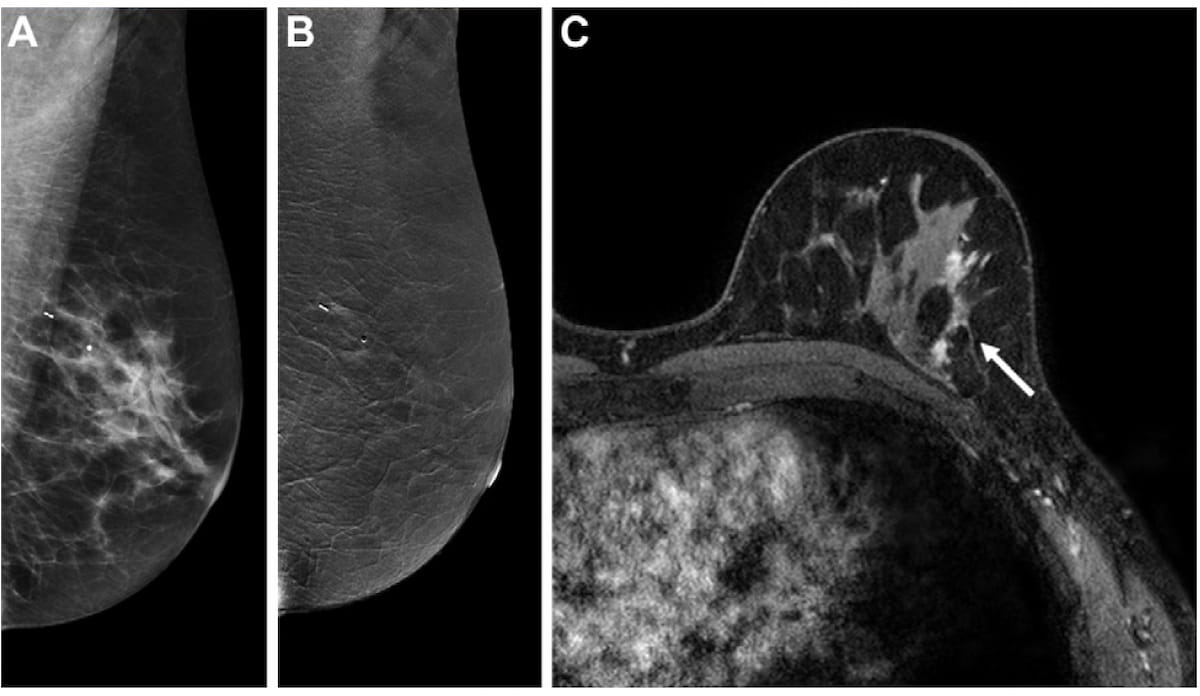Study Reveals Tradeoffs Between Contrast-Enhanced Mammography and MRI for Supplemental Screening
In a new study comparing standard breast MRI, abbreviated breast MRI and contrast-enhanced mammography in supplemental breast cancer screening, researchers found that MRI offered a greater than 14 percent higher cancer detection rate and a nearly 39 percent higher sensitivity rate than CEM.
What is the best supplemental imaging for breast cancer screening: standard breast magnetic resonance imaging (MRI), abbreviated breast MRI (ABMRI) and contrast-enhanced mammography (CEM)?
Researchers sought the answer to that question in a comparative prospective study of the imaging modalities recently published in Radiology. The study cohort was comprised of 246 women (median age of 51) who had a standard breast MRI and a subsequent CEM exam. The ABMRI imaging was generated from the standard MRI exam, according to the study.
Standard MRI and ABMRI had significantly higher sensitivity rates (88.9 percent and 100 percent respectively) in comparison to CEM (61.1 percent). The researchers also projected higher cancer detection per 1,000 examinations with standard MRI (36.6) and ABMRI (32.5) in contrast to CEM (22.4).
However, CEM had a higher specificity rate (87.8 percent in comparison to 75.7 percent for ABMRI and 80.2 percent for standard MRI, according to the study authors. The researchers noted that CEM had a lower recall rate (14 percent) than standard MRI (22.8 percent) and ABMRI (26.6 percent). The study authors also projected a significantly reduced number of false positive biopsy recommendations per 1,000 examinations for CEM (65) in comparison to standard MRI (162.6) and ABMRI (180.9).
“These results suggest CEM in the screening setting has the potential to improve timeliness of screening with fewer diagnostic evaluations and biopsies that ultimately reveal benign disease,” wrote lead study author Marissa B. Lawson, M.D., an assistant professor in the Department of Radiology at the University of Washington in Seattle, and colleagues.
The above images for a 61-year-old study participant with partner and localizer of breast cancer gene 2 (PALB-2) reveal false-negative CEM findings (A and B) and a true-positive finding with MRI/abbreviated breast MRI (C). (Images courtesy of Radiology.)

Prior to clinical adoption of CEM in screening settings, the researchers emphasized ongoing assessment of the imaging modality for those with intermediate breast cancer risk and women with elevated risks due to previous breast cancer history or extremely dense breasts.
Noting no significant cancer detection differences between standard MRI and abbreviated MRI in the study, the researchers noted the efficiency achieved with abbreviated MRI may facilitate wider use of the imaging modality for supplemental screening in high-risk patients.
“Similar to standard MRI, ABMRI relies on differential uptake of intravenous contrast agent in identifying malignancy in lesions due to neoangiogenesis, but with fewer dynamic sequences compared with the standard protocol,” noted Lawson and colleagues. “These abbreviated examinations have demonstrated similar performance compared with standard MRI while decreasing acquisition and interpretation time. This efficient approach could increase MRI capacity and allow for greater access to MRI screening.”
In regard to study limitations, the researchers noted a small number of detected cancers in the cohort and said this was particularly the case with standard MRI scans. They also acknowledged a potential bias toward standard MRI as all pathologic diagnoses of breast cancer were made with standard MRI whereas findings specific to CME or ABMRI were not biopsied, and they observed no interval cancers with these modalities. The reviewing readers also had “relative inexperience” with CEM in comparison to standard MRI and ABMRI, according to the study authors.
Emerging AI Algorithm Shows Promise for Abbreviated Breast MRI in Multicenter Study
April 25th 2025An artificial intelligence algorithm for dynamic contrast-enhanced breast MRI offered a 93.9 percent AUC for breast cancer detection, and a 92.3 percent sensitivity in BI-RADS 3 cases, according to new research presented at the Society for Breast Imaging (SBI) conference.
Could AI-Powered Abbreviated MRI Reinvent Detection for Structural Abnormalities of the Knee?
April 24th 2025Employing deep learning image reconstruction, parallel imaging and multi-slice acceleration in a sub-five-minute 3T knee MRI, researchers noted 100 percent sensitivity and 99 percent specificity for anterior cruciate ligament (ACL) tears.